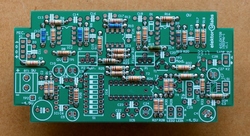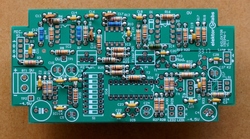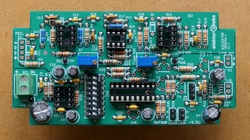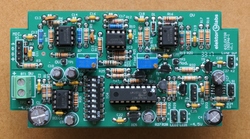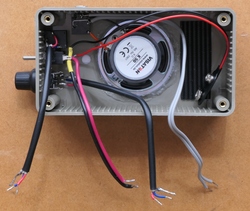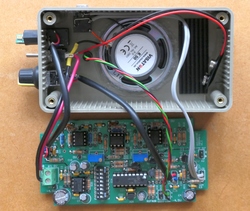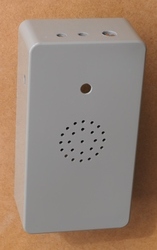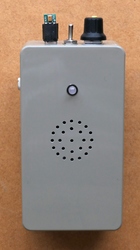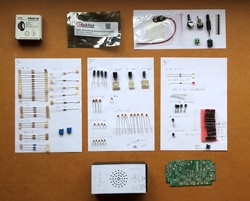

Introduction
Site list (GPS fixes) Walks (GPS tracks) Video clips Panoramas
Electronic projects:
Bat detector
Lamp tests
µ-controlled lamp
SEPIC-based lamp
ISP isolators
Making SMT boards
Expedition logs:
Spain 1973, 1974,
1975, 1976, 1977,
1979, 1982, 1983,
1985, 1986, 1987,
1988, 1989, 2000,
2001, 2002, 2003,
2004, 2005, 2006,
2007, 2008, 2009,
2010, 2011, 2012,
2013, 2014, 2015,
2016, 2017, 2018,
2019, 2020, 2021,
2022, 2023
Mexico
New England
Translation:
This bat detector is different from most in that it makes the ultrasonic bat calls audible (to us) by digitally dividing the frequency of the calls, converting the resulting square wave to a sine wave, and then re-applying the amplitude information to give an indication of the original signal amplitude. It is described in detail in the Bat DetectorPLUS project article by Kenneth Horton (Elektor 4/2016, July/ & August 2016, pp 82–92).
We used the kit of parts supplied by Elektor », which includes all the components and hardware (except for various connecting wires, 9V battery, and a volume-control knob) for the Bat Detector. (Read from bottom upwards for a chronological build sequence.)
Detailed information and background links:
- www.elektormagazine.com/150346 » – the Elektor project followed
- www.bats.org.uk/ » – general bat information, sample detector sounds, etc.
- www.durhambats.org.uk/batcalls.shtml » – summary of UK bat calls
- www.skillbank.co.uk/bat_detectors/index.html » – describes prototype of this detector
Testing
2019.05.16 The detector was first bench-tested by checking power-supply input impedance, then setting up as suggested by the Elektor article (altough the second part did not work as described; see 2019.06.07 remarks). No problems were found and everything worked first time. Later (21:15) the same day, despite it being unpromisingly cold and blustery (9°C, 32kph gusts), a prowl of the garden was effected and two unmistakable bat calls were heard. Device declared a success, although more field testing is planned when there is a calmer and warmer evening.
Note: the Green/Red single LED indicator worked very well, with the (rare) both-on ‘invalid signal’ showing as yellow, as expected.
2019.05.17 Visited Tocil wood in the evening; just one bat detected at 20:45, but after a ‘Dirty Duck’ University Pub diversion, there were many, many bats an hour later (shortly before sunset).
2019.06.07 Thorough investigation of why setup using P2 did not work as expected, using oscilloscope, signal generators, etc. Net: the MEMs microphone is generating so little noise that the Schmitt trigger circuit does not flip even when P2 is at minimum (about 0.2Ω). Instead it stays high (4.5V) and flickers down by a volt or so; adjusted P2 to the point that the ‘flicker’ barely happened. Audible performance is essentially the same whatever the setting.
Also measured power consumption:
No signal (muted): 4.0mA (in this state T2 is always on, so sinks about 0.7mA)
With regular signal (40KHz): 16.8 mA .
2019.06.14 After many discussions with the very helpful Ken Horton, and a number of experiments, I ordered a replacement MEMS microphone. With the new microphone the setup of P2 worked as expected.
Building
The constructor (MFC) had forgotten how much slower it is to build with ‘through-hole components’ – last used (other than when breadboarding) more than 15 years ago. A ‘retro’ but enjoyable and straightforward experience.| Click or tap any thumbnail for a full-size image. | |
Building followed the conventional order of passives then actives, smallest first, followed by edge connectors. The only change suggested to that order, in hindsight, would be to mount the SMD component (audio amplifier, lower-right in the photos) before the large capacitors.
Wiring up the hardware was a little fiddly, especially as suitable thin flexible 2-core shielded cable could not be sourced, so less-than-flexible ‘data cable’ (black in the photos) was used. Also, hot glue was used for the first time for mounting the loudspeaker and vibration-proofing the other hardware; more experience would have have given a neater result.
The next two show the case after drilling, and later when completed and bench-tested.
‘Unboxing’
Construction of the kit was delayed for several reasons, but was started in May 2019. One previous builder had reported missing components, so a full check and mise en place of the components was carried out; all were present and correct – see image at right.At this stage, some thought was put into the mechanical design (user interface) of the detector. In particular:
- The suggested layout had the volume control central on the front of the box, with a slide on/off switch on the right side of the box. The kit included a toggle switch rather than a slide switch, so it was decided to move the on-off switch and the volume control to the top of the box (as in hand-held radios) to keep the package slimmer. The microphone socket was moved to top left to make space for the controls.
- The article suggested placing a blue ‘signal’ LED above and to
the left and a red ‘mute’ LED above and to the right of the volume
control (on the front). These were replaced by a single green/red
(two LEDs in one package) indicator (this was the only electronic
change made to the original design). The LED indicator was mounted
on the box front.
An RGB LED (using blue and red) could be used instead if the detector might be used by a colour-blind person.
- The resulting 1:1 layout (also with fewer loudspeaker holes) is shown in this PDF file. The layout includes the position for a second 3.5mm socket on the left side for line-out or headphones (we added a switched headphone socket – there is plenty of room to add a line-out socket, too).
- We used an identical-specification ‘grey’ box that happened to be on hand rather than the supplied ‘shiny black’ box.
Kit source
The ‘Bat Detector Plus’ kit (Bat detector with amplitude recovery, 150346-71) was purchased in April 2018 from Elektor, for £44 plus shipping. The Elektor page for the product is www.elektormagazine.com/labs/bat-detector-with-amplitude-recovery » – this page has several resources, including images, PCB layout, etc.
